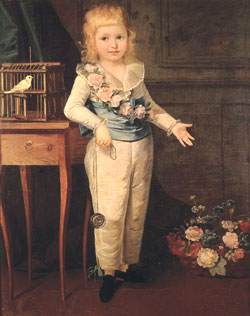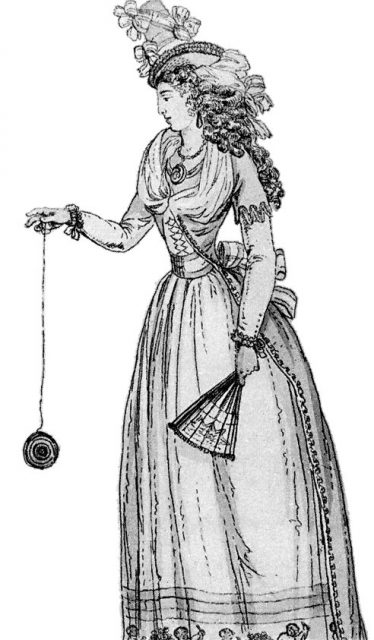Ever wondered how toys looked 2,500 years ago? Well, the answer to that question is―the same as today. At least to some degree, for dolls of all kinds are confirmed to have existed as part of everyday life even in ancient times. Second only to dolls, which are considered to be the oldest known toys to survive throughout the centuries, one toy remains as captivating as ever.
The Yo-Yo is believed to have originated from a Chinese toy known as the Diabolo. From China, it is thought that the toy expanded its popularity in two directions. The first was toward Europe, Ancient Greece to be more exact, and secondly to the Philippines, in southeast Asia.
In Greece, a yo-yo resembling toy can be seen on vases dating from the year 500 B.C., which happens to be the first official mention of this pastime invention in history. Greek society was based on a number of initiation rituals, and it is today believed that the toy, mostly made of wood, clay, or even metal, served as an offering to the gods in order to signify the coming of age of the child. Due to its fragile nature, clay was the most probable option when it came to the ritual offerings, while wood and metal were used for kids entertainment. Images depicting similar objects were also found in Egypt, which illustrates the way this curious device traveled the world, captivating minds of grown-ups and children alike.
Vases depicting the toy, as well as remains of a terracotta disc that was used to form this simple entrapment, can be seen exhibited in the National Museum of Athens, Greece.

As for the evolution of yo-yo in the Far East, it went from the favorite pastime of children to a deadly weapon used both for hunting and warfare. In the 16th century, Philippines warriors would climb a tree and wait for their prey with a larger, sharpened device made of rock, which functioned on the same principle as the toy. The word itself means “come-come” or “to return” in Filipino, describing the basic trait of the toy. Thus, the modern name is considered to be derived from the Filipino language.

In 1765, the yo-yo emerged in India, from where it traveled back to Europe as an exotic and mysterious plaything of the Orient. Around the French Revolution of 1789, it was already spread among the aristocracy as a means to reduce stress and tension by continuously performing the repetitive action of “yo-yo-ing”. Of course, in France, it was known by different names; it was dubbed the “L’emigrette,” “Bandalore,” and “joujou de Normandie.” Some would argue that the French word for a toy―joujou―was adopted into other western cultures as the name for the device, but others beg to differ, supporting the Filipino theory.
In late 18th century England the yo-yo was largely popularized by the Prince of Wales, who turned it into a trend among the young dandies and aristocrats. It was further popularized by the French playwright, Beaumarchais, who mentions the toy in his treatment of Figaro, where the title character also notes the advantages of the toy as a stress reliever:
It is a noble toy, which dispels the fatigue of thinking.

As for the United States, it almost took another 100 years for the viral game to reach its shores. In 1866, two men from Ohio offered their “improved bandalore” which was introduced in a similar manner as in Europe.
Jump forward another half-a-century, to 1916, when the Scientific American Supplement published an article titled “Filipino Toys,” which precisely depicted it in its current form and named it a yo-yo. Twelve years later, Pedro Flores, a Filipino emigre, opened the first yo-yo manufacturing shop in California and the hype was on.

Soon after, an influential businessman called Donald F. Duncan Sr. bought off Flores’ factory which was at the time producing more than 300,000 units daily. Needless to say, a number of improvements were made, enabling new tricks and new ways to operate the toy, such as the famous “sleeping” and “walking the dog.”
Thanks to Duncan’s gift for business and advertising, the yo-yo gained a great surge in popularity, both in North America and Europe. Soon competition arrived, but since the Yo-Yo trademark was in Donald Duncan’s possession, no one was able to really compete, as knock-offs were forced to use names such as “come-back,” “return,” “returning top,” “whirl-a-gig,” and “twirler,” while everyone knew that Yo-Yo did it first and does it better.

Unfortunately, each hype meets its bitter end, and so was the case for the rolling discs on a string. Donald Duncan’s company went into bankruptcy in 1965, after selling more than 45 million yo-yo toys to kids and adults all over the world.
Nevertheless, the toy is still considered popular and has since achieved a cult status. The World Yo-Yo Contest continues to attract numerous enthusiasts who wish to show off their skills. The toy remains most popular in Japan, the U.S., and the Czech Republic, which hosted the contest in 2014–the first ever competition held outside of North America. In addition to its omnipresence in popular culture, yo-yo was the first toy ever to reach outer space, when astronaut David Griggs brought it with him on the 1985 shuttle mission.
